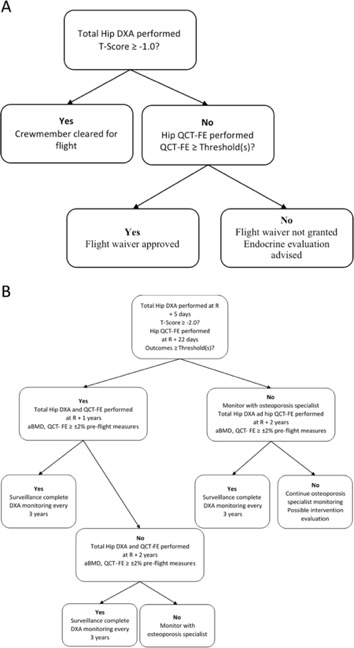As with other biological systems, the bones of the skeletal system change in a microgravity environment. Bone loss with spaceflight is analogous to osteoporosis and potentially leads to an increased risk of fracture. Current astronaut medical standards are adapted from clinical guidelines for osteoporosis diagnosis; however, the osteoporosis clinical guidelines were developed for a different demographic and may not be appropriate for the astronaut demographic. To address these concerns, the NASA Finite Element Strength Task Group was created to propose alternative health guidelines for astronaut skeletal strength to complement current astronaut medical standards.
This work presents the conclusion of an eight-year international effort to propose guidelines for skeletal health using cut-points of estimated hip bone load capacity (strength). These recommended guidelines identify acceptable ranges of astronaut skeletal health for screening astronaut corps applicants, pre-spaceflight mission minimum standards, and post-spaceflight mission standards. The proposed use of finite element analysis, a computational tool engineers use to estimate structural strength of a material, and computed tomography (CT) medical imaging is an evidence-based application for skeletal health assessment.
Establishing these skeletal health recommendations was an international undertaking. Terrestrial scan cohorts of the general aging population were donated by the Mayo Clinic (Rochester, MN) and the AGES cohort (Reykjavik, Iceland). Scan calibrations and finite element analyses were performed in San Francisco, CA and Irvine, CA. Experts from the research field and members of the task group were asked to participate from across the United States as well as Canada. Study coordination and data management was centralized in Houston, TX at NASA Johnson Space Center.
Four recommendations were determined by the task group to complement the current NASA skeletal health standards. First, a minimum permissible outcome limit for post-mission hip bone load capacity was identified. Second, finite element hip load capacity is an additional measure for astronaut corps applicants. Third, a minimum pre-flight standard was established for a second long-duration mission. Finally, a method is described to assess post-mission physical activities that may increase the risk of fracture.

Additionally, we recommend a pipeline to integrate the finite element analysis into pre-flight (Figure A) and post-flight (Figure B) monitoring as a standard operating procedure and a comprehensive index for follow post-flight skeletal health recovery. Our work bridges the gap between clinical relevance and research used to describe the unique skeletal effects due to spaceflight and microgravity’s possible effect on astronaut performance and long-term health.
Article:
Hip load capacity cut-points for Astronaut Skeletal Health: NASA Finite Element Strength Task Group Recommendations
Link: https://rdcu.be/bIDPg
Follow the Topic
-
npj Microgravity

This journal aims to provide a thorough understanding of the scientific impact and future of spaceflight research.
Related Collections
With Collections, you can get published faster and increase your visibility.
Space Biomanufacturing
Publishing Model: Open Access
Deadline: Mar 15, 2026



Please sign in or register for FREE
If you are a registered user on Research Communities by Springer Nature, please sign in